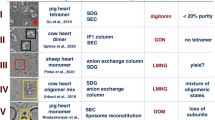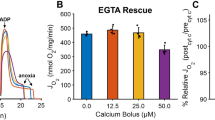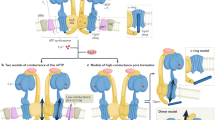Abstract
Mitochondrial permeability transition (mPT) refers to a sudden increase in the permeability of the inner mitochondrial membrane. Long-term studies of mPT revealed that this phenomenon has a critical role in multiple pathophysiological processes. mPT is mediated by the opening of a complex termed the mPT pore (mPTP), which is responsible for the osmotic influx of water into the mitochondrial matrix, resulting in swelling of mitochondria and dissipation of the mitochondrial membrane potential. Here we provide three independent optimized protocols for monitoring mPT in living cells: (i) measurement using a calcein–cobalt technique, (ii) measurement of the mPTP-dependent alteration of the mitochondrial membrane potential, and (iii) measurement of mitochondrial swelling. These procedures can easily be modified and adapted to different cell types. Cell culture and preparation of the samples are estimated to take ∼1 d for methods (i) and (ii), and ∼3 d for method (iii). The entire experiment, including analyses, takes ∼2 h.
This is a preview of subscription content, access via your institution
Access options
Subscribe to this journal
Receive 12 print issues and online access
$259.00 per year
only $21.58 per issue
Buy this article
- Purchase on Springer Link
- Instant access to full article PDF
Prices may be subject to local taxes which are calculated during checkout



Similar content being viewed by others
References
Zoratti, M. & Szabo, I. The mitochondrial permeability transition. Biochim. Biophys. Acta 1241, 139–176 (1995).
Kwong, J.Q. & Molkentin, J.D. Physiological and pathological roles of the mitochondrial permeability transition pore in the heart. Cell Metab. 21, 206–214 (2015).
Bernardi, P. & Di Lisa, F. The mitochondrial permeability transition pore: molecular nature and role as a target in cardioprotection. J. Mol. Cell. Cardiol. 78, 100–106 (2015).
Bonora, M. et al. Molecular mechanisms of cell death: central implication of ATP synthase in mitochondrial permeability transition. Oncogene 34, 1475–1486 (2015).
Halestrap, A.P. The C ring of the F1Fo ATP synthase forms the mitochondrial permeability transition pore: a critical appraisal. Front. Oncol. 4, 234 (2014).
Halestrap, A.P. & Richardson, A.P. The mitochondrial permeability transition: a current perspective on its identity and role in ischaemia/reperfusion injury. J. Mol. Cell. Cardiol. 78, 129–141 (2015).
Morciano, G. et al. Molecular identity of the mitochondrial permeability transition pore and its role in ischemia-reperfusion injury. J. Mol. Cell. Cardiol. 78, 142–153 (2015).
Bonora, M. et al. Role of the c subunit of the FO ATP synthase in mitochondrial permeability transition. Cell Cycle 12, 674–683 (2013).
De Marchi, E., Bonora, M., Giorgi, C. & Pinton, P. The mitochondrial permeability transition pore is a dispensable element for mitochondrial calcium efflux. Cell Calcium 56, 1–13 (2014).
Alavian, K.N. et al. An uncoupling channel within the c-subunit ring of the F1FO ATP synthase is the mitochondrial permeability transition pore. Proc. Natl. Acad. Sci. USA 111, 10580–10585 (2014).
Azarashvili, T. et al. Potential role of subunit c of F0F1-ATPase and subunit c of storage body in the mitochondrial permeability transition. Effect of the phosphorylation status of subunit c on pore opening. Cell Calcium 55, 69–77 (2014).
Crofts, A.R. & Chappell, J.B. Calcium ion accumulation and volume changes of isolated liver mitochondria. Reversal of calcium ion-induced swelling. Biochem. J. 95, 387–392 (1965).
Chappell, J.B. & Crofts, A.R. Calcium ion accumulation and volume changes of isolated liver mitochondria. Calcium ion-induced swelling. Biochem. J. 95, 378–386 (1965).
Hausenloy, D.J., Duchen, M.R. & Yellon, D.M. Inhibiting mitochondrial permeability transition pore opening at reperfusion protects against ischaemia-reperfusion injury. Cardiovas. Res. 60, 617–625 (2003).
Wieckowski, M.R. & Wojtczak, L. Fatty acid-induced uncoupling of oxidative phosphorylation is partly due to opening of the mitochondrial permeability transition pore. FEBS Lett. 423, 339–342 (1998).
Gautier, C.A. et al. Regulation of mitochondrial permeability transition pore by PINK1. Mol. Neurodegener. 7, 22 (2012).
Crompton, M. The mitochondrial permeability transition pore and its role in cell death. Biochem. J. 341, 233–249 (1999).
Wong, R., Steenbergen, C. & Murphy, E. Mitochondrial permeability transition pore and calcium handling. Methods Mol. Biol. 810, 235–242 (2012).
Marcu, R., Neeley, C.K., Karamanlidis, G. & Hawkins, B.J. Multi-parameter measurement of the permeability transition pore opening in isolated mouse heart mitochondria. J. Vis. Exp. 67 (2012).
Varanyuwatana, P. & Halestrap, A.P. The roles of phosphate and the phosphate carrier in the mitochondrial permeability transition pore. Mitochondrion 12, 120–125 (2012).
Piwocka, K. et al. A novel apoptosis-like pathway, independent of mitochondria and caspases, induced by curcumin in human lymphoblastoid T (Jurkat) cells. Exp. Cell Res. 249, 299–307 (1999).
Griffiths, E.J. & Halestrap, A.P. Mitochondrial non-specific pores remain closed during cardiac ischaemia, but open upon reperfusion. Biochem. J. 307, 93–98 (1995).
Gillessen, T., Grasshoff, C. & Szinicz, L. Biomed. Pharmacother. 56, 186–193 (2002).
Hausenloy, D., Wynne, A., Duchen, M. & Yellon, D. Transient mitochondrial permeability transition pore opening mediates preconditioning-induced protection. Circulation 109, 1714–1717 (2004).
Petronilli, V. et al. Transient and long-lasting openings of the mitochondrial permeability transition pore can be monitored directly in intact cells by changes in mitochondrial calcein fluorescence. Biophys. J. 76, 725–734 (1999).
Woollacott, A.J. & Simpson, P.B. High throughput fluorescence assays for the measurement of mitochondrial activity in intact human neuroblastoma cells. J. Biomol. Screen. 6, 413–420 (2001).
Petronilli, V. et al. Transient and long-lasting openings of the mitochondrial permeability transition pore can be monitored directly in intact cells by changes in mitochondrial calcein fluorescence. Biophys. J. 76, 725–734 (1999).
Feldmann, G. et al. Opening of the mitochondrial permeability transition pore causes matrix expansion and outer membrane rupture in Fas-mediated hepatic apoptosis in mice. Hepatology 31, 674–683 (2000).
Wakabayashi, T. Structural changes of mitochondria related to apoptosis: swelling and megamitochondria formation. Acta Biochim. Pol. 46, 223–237 (1999).
Kaasik, A., Safiulina, D., Zharkovsky, A. & Veksler, V. Regulation of mitochondrial matrix volume. Am. J. Phys. 292, C157–C163 (2007).
Song, W. et al. Assessing mitochondrial morphology and dynamics using fluorescence wide-field microscopy and 3D image processing. Methods 46, 295–303 (2008).
Leonard, A.P. et al. Quantitative analysis of mitochondrial morphology and membrane potential in living cells using high-content imaging, machine learning, and morphological binning. Biochim. Biophys. Acta 1853, 348–360 (2015).
Reis, Y. et al. Multi-parametric analysis and modeling of relationships between mitochondrial morphology and apoptosis. PLoS One 7, e28694 (2012).
Nicholls, D.G. Simultaneous monitoring of ionophore- and inhibitor-mediated plasma and mitochondrial membrane potential changes in cultured neurons. J. Biol. Chem. 281, 14864–14874 (2006).
Loew, L.M., Carrington, W., Tuft, R.A. & Fay, F.S. Physiological cytosolic Ca2+ transients evoke concurrent mitochondrial depolarizations. Proc. Natl. Acad. Sci. USA 91, 12579–12583 (1994).
Haworth, R.A. & Hunter, D.R. The Ca2+-induced membrane transition in mitochondria. II. Nature of the Ca2+ trigger site. Arch. Biochem. Biophys. 195, 460–467 (1979).
Takeyama, N., Matsuo, N. & Tanaka, T. Oxidative damage to mitochondria is mediated by the Ca(2+)-dependent inner-membrane permeability transition. Biochem. J. 294, 719–725 (1993).
Kowaltowski, A.J., Castilho, R.F. & Vercesi, A.E. Mitochondrial permeability transition and oxidative stress. FEBS Lett. 495, 12–15 (2001).
Petronilli, V. et al. The voltage sensor of the mitochondrial permeability transition pore is tuned by the oxidation-reduction state of vicinal thiols. Increase of the gating potential by oxidants and its reversal by reducing agents. J. Biol. Chem. 269, 16638–16642 (1994).
Bravo, C., Chavez, E., Rodriguez, J.S. & Moreno-Sanchez, R. The mitochondrial membrane permeability transition induced by inorganic phosphate or inorganic arsenate. A comparative study. Comp. Biochem. Physiol. B Biochem. Mol. Biol. 117, 93–99 (1997).
Kowaltowski, A.J., Castilho, R.F. & Vercesi, A.E. Opening of the mitochondrial permeability transition pore by uncoupling or inorganic phosphate in the presence of Ca2+ is dependent on mitochondrial-generated reactive oxygen species. FEBS Lett. 378, 150–152 (1996).
Wieckowski, M.R., Brdiczka, D. & Wojtczak, L. Long-chain fatty acids promote opening of the reconstituted mitochondrial permeability transition pore. FEBS Lett. 484, 61–64 (2000).
Beutner, G., Ruck, A., Riede, B., Welte, W. & Brdiczka, D. Complexes between kinases, mitochondrial porin and adenylate translocator in rat brain resemble the permeability transition pore. FEBS Lett. 396, 189–195 (1996).
Pfeiffer, D.R., Gudz, T.I., Novgorodov, S.A. & Erdahl, W.L. The peptide mastoparan is a potent facilitator of the mitochondrial permeability transition. J. Biol. Chem. 270, 4923–4932 (1995).
Li, J., Wang, J. & Zeng, Y. Peripheral benzodiazepine receptor ligand, PK11195 induces mitochondria cytochrome c release and dissipation of mitochondria potential via induction of mitochondria permeability transition. Eur. J. Pharmacol. 560, 117–122 (2007).
Vianello, A. et al. The mitochondrial permeability transition pore (PTP)-an example of multiple molecular exaptation? Biochim. Biophys. Acta 1817, 2072–2086 (2012).
Rizzuto, R., Brini, M., Pizzo, P., Murgia, M. & Pozzan, T. Chimeric green fluorescent protein as a tool for visualizing subcellular organelles in living cells. Curr. Biol. 5, 635–642 (1995).
Schindelin, J. et al. Fiji: an open-source platform for biological-image analysis. Nat. Methods 9, 676–682 (2012).
Di Virgilio, F., Fasolato, C. & Steinberg, T.H. Inhibitors of membrane transport system for organic anions block fura-2 excretion from PC12 and N2A cells. Biochem. J. 256, 959–963 (1988).
Crompton, M., Ellinger, H. & Costi, A. Inhibition by cyclosporin A of a Ca2+-dependent pore in heart mitochondria activated by inorganic phosphate and oxidative stress. Biochem. J. 255, 357–360 (1988).
Baines, C.P. et al. Loss of cyclophilin D reveals a critical role for mitochondrial permeability transition in cell death. Nature 434, 658–662 (2005).
Kroemer, G., Galluzzi, L. & Brenner, C. Mitochondrial membrane permeabilization in cell death. Physiol. Rev. 87, 99–163 (2007).
Goedhart, J. et al. Structure-guided evolution of cyan fluorescent proteins towards a quantum yield of 93%. Nat. Commun. 3, 751 (2012).
Sarkar, A.R. et al. Red emissive two-photon probe for real-time imaging of mitochondria trafficking. Anal. Chem. 86, 5638–5641 (2014).
Morozova, K.S. et al. MFar-red fluorescent protein excitable with red lasers for flow cytometry and superresolution STED nanoscopy. Biophys. J. 99, L13–L15 (2010).
Dumas, J.F. et al. Effect of transient and permanent permeability transition pore opening on NAD(P)H localization in intact cells. J. Biol. Chem. 284, 15117–15125 (2009).
Bejarano, I. et al. Role of calcium signals on hydrogen peroxide-induced apoptosis in human myeloid HL-60 Cells. Int. J. Biomed. Sci. 5, 246–256 (2009).
Deniaud, A. et al. Endoplasmic reticulum stress induces calcium-dependent permeability transition, mitochondrial outer membrane permeabilization and apoptosis. Oncogene 27, 285–299 (2008).
Gerasimenko, J.V. et al. Menadione-induced apoptosis: roles of cytosolic Ca(2+) elevations and the mitochondrial permeability transition pore. J. Cell Sci. 115, 485–497 (2002).
Loor, G. et al. Menadione triggers cell death through ROS-dependent mechanisms involving PARP activation without requiring apoptosis. Free Radic. Biol. Med. 49, 1925–1936 (2010).
Novgorodov, S.A. & Gudz, T.I. Ceramide and mitochondria in ischemic brain injury. Int. J. Biochem. Mol. Biol. 2, 347–361 (2011).
Parra, V. et al. Changes in mitochondrial dynamics during ceramide-induced cardiomyocyte early apoptosis. Cardiovasc. Res. 77, 387–397 (2008).
Perry, S.W., Norman, J.P., Barbieri, J., Brown, E.B. & Gelbard, H.A. Mitochondrial membrane potential probes and the proton gradient: a practical usage guide. Biotechniques 50, 98–115 (2011).
Salvioli, S., Ardizzoni, A., Franceschi, C. & Cossarizza, A. JC-1, but not DiOC6(3) or rhodamine 123, is a reliable fluorescent probe to assess delta psi changes in intact cells: implications for studies on mitochondrial functionality during apoptosis. FEBS Lett. 411, 77–82 (1997).
Ohno, R., Koie, K., Kamiya, T., Kawashima, K. & Ishiguro, J. [Treatment of pulmonary infections probably caused by fungi in patients with acute leukemia with chlotrimazole (author's transl.)]. Rinsho Ketsueki 17, 876–883 (1976).
Acknowledgements
P.P. is grateful to Camilla degli Scrovegni for continuous support. This research was supported by the Italian Ministry of Education, University and Research (COFIN no. 20129JLHSY_002, FIRB no. RBAP11FXBC_002, and Futuro in Ricerca no. RBFR10EGVP_001), local funds from the University of Ferrara and the Italian Ministry of Health to P.P. and C.G., Telethon (GGP15219/B), the Italian Association for Cancer Research (IG-14442 and MFAG-13521 to P.P. and C.G.), and the Italian Cystic Fibrosis Research Foundation (19/2014) to P.P. M.R.W. was supported by the National Science Centre, Poland (grant 2014/15/B/NZ1/00490), grant W100/HFSC/2011, and HFSP grant RGP0027/2011.
Author information
Authors and Affiliations
Contributions
M.B., C.M., G.M., C.G., M.R.W., and P.P. contributed extensively to the writing of this paper. M.B., G.M., and C.M. performed the experiments, analyzed data, and generated visual guides.
Corresponding author
Ethics declarations
Competing interests
The authors declare no competing financial interests.
Integrated supplementary information
Supplementary Figure 1 Typical improper results
Example of typical experimental artifacts in the Co2+-calcein (A), mitochondrial membrane potential (B) and mitochondrial morphology assays (C). For solutions to these problem, refer to Table 2.
Supplementary information
Rights and permissions
About this article
Cite this article
Bonora, M., Morganti, C., Morciano, G. et al. Comprehensive analysis of mitochondrial permeability transition pore activity in living cells using fluorescence-imaging-based techniques. Nat Protoc 11, 1067–1080 (2016). https://doi.org/10.1038/nprot.2016.064
Published:
Issue Date:
DOI: https://doi.org/10.1038/nprot.2016.064
This article is cited by
-
Assessment of cytotoxicity and antioxidant properties of berry leaves as by-products with potential application in cosmetic and pharmaceutical products
Scientific Reports (2021)
-
The mitochondrial permeability transition phenomenon elucidated by cryo-EM reveals the genuine impact of calcium overload on mitochondrial structure and function
Scientific Reports (2021)
-
Potentiation of the apoptotic signaling pathway in both the striatum and hippocampus and neurobehavioral impairment in rats exposed chronically to a low−dose of cadmium
Environmental Science and Pollution Research (2021)
-
The iron chelator Deferasirox causes severe mitochondrial swelling without depolarization due to a specific effect on inner membrane permeability
Scientific Reports (2020)
-
Susceptibility to cellular stress in PS1 mutant N2a cells is associated with mitochondrial defects and altered calcium homeostasis
Scientific Reports (2020)
Comments
By submitting a comment you agree to abide by our Terms and Community Guidelines. If you find something abusive or that does not comply with our terms or guidelines please flag it as inappropriate.



